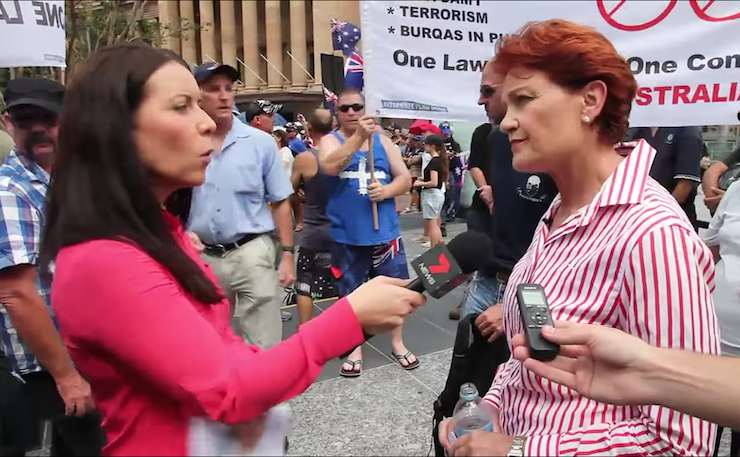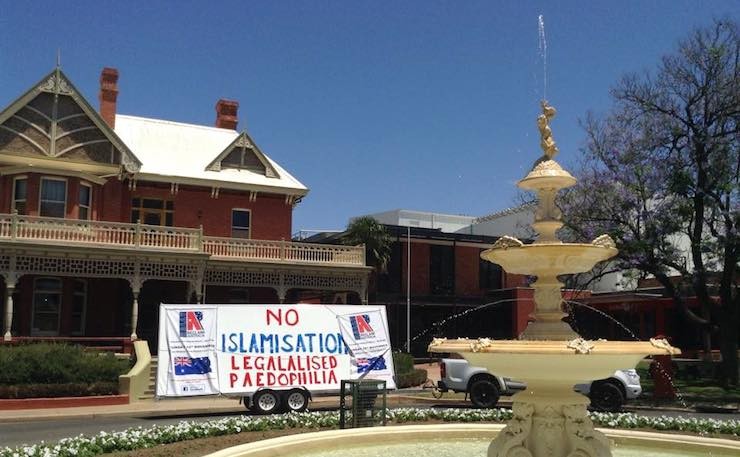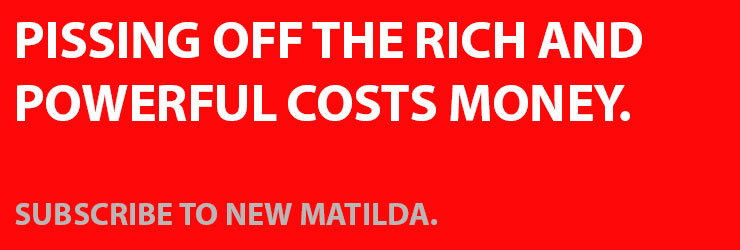The anti-Muslim movement feeds off an ideology that finds its roots in the 1980s. Then as now, it has been propagated by conservative think tanks, journalists, and corporate interests, writes Sam Oldham.
The weekend’s clashes between anti-Muslim and anti-racist groups are the latest in a conflict that portends to escalate before it is resolved. It is a conflict that continues to be played out between working Australians.
The entire leadership of far-right United Patriots Front (UPF) group, including the recently interned Phillip Galea, are labourers or tradespeople, as are many of the ‘concerned mums and dads’ of Reclaim Australia. Likewise are those who bear the brunt of far-right aggression. No Room for Racism is comprised overwhelmingly of young workers and students. Trade unions have been dragged into the fray, as have their supporters, the 3CR radio station being targeted by the UPF in recent weeks.
Yet the ideas of the far-right have origins that are distant from the working-class, a fact that is too often absent from the discourse around the re-emergence of the far-right. Andrew Markus, a leading authority on Australian race relations, has observed that organised political opposition to multiculturalism began with the rise of the New Right in the 1980s and 1990s, when it was pushed by corporate thinktanks, including the Institute of Public Affairs, the Centre for Policy Studies, the Centre for Independent Studies, and the industry groups that supported them.
The conservative journal Quadrant was an important mouthpiece for this initial crusade, trumpeting ‘sources of pride’ in ‘Australian values’ against the influence of ‘radical multiculturalists’. The historian Geoffrey Blainey was actively patronised by the New Right and its industry groups (he was inducted into the Mining Hall of Fame as ‘a fearless advocate of the interests of the mining industry’). Blainey actively propagated against Asian immigration. One survey found over 350 of his newspaper articles on Asian immigration published by Murdoch and Fairfax newspapers between March and September in 1984.
It is notable that this power bloc was also the first to attack the policies of affirmative action for Aboriginal people introduced under Whitlam. Hugh Morgan, a leading member of the IPA and a former director of Western Mining Corporation, was a major propagandist in the campaign to oppose Aboriginal land rights in 1983-84. Native title for Aboriginal people represented a grave threat the mining industry. Through mass persuasion, it was attacked on grounds that ‘land rights should be equal rights’, where mining companies and traditional inhabitants had equal claim.
Morgan and his allies flooded the media, framing their message in opposition to ‘special treatment’ for Aboriginal people. Morgan was open about his role as a propagandist: “You won’t get change through politicians . . . Politicians can only accept what is accepted in the opinion polls. So you have to change public opinion!”

The Murdoch media (with historically close ties to the IPA) has always been enthusiastic in promoting opposition to both multiculturalism and Aboriginal land rights, and was instrumental in the turn to anti-Arab propaganda. In 1991, the Human Rights and Equal Opportunity Commission for the first time reported that “media portrayals were seen as demonstrating fundamental ignorance of Islam and as perpetuating negative and destructive stereotypes”. These were “having the effect of raising the tensions in the community and may have been contributing to an increase in acts of racial hostility against Muslims and Arabs.” An important piece of research points to the Daily Telegraph specifically, observing that negative media portrayals of Arabs and Muslims continued throughout the 1990s. In particular, this period saw the rise of ‘moral panics’ about Middle Eastern crime gangs, in “media driven cycles of fear”.
Immigrants and other minority groups provided a distraction from the explosion of social inequality as a result of New Right economic policies, as well as a scapegoat for popular discontent. Academic studies again highlight these connections. A 1991 study concludes that socio-economic status and economic insecurity “have proven to be significant determinants of attitudes toward immigration.” Other research suggests that “support for political parties with racially discriminatory policies was strongly linked to disenchantment born of social polarisation.” Mass-based racist voting patterns were, after all, seen for the first time in the 1996 Federal Election, as were political parties with explicitly anti-Muslim policies.
Political racism closely parallels the rise of the New Right internationally. Racist skinheadism in the UK, a precursor to the contemporary English Defence League, first appeared under Thatcher. The film This is England (2006) offers a chilling representation of its development. Michael Kimmel, in his book Angry White Men, identifies “noticeable patterns” in the rise of the American far-right over two decades. “Buffeted by global political and economic forces,” the far-right emerged from “the single-story working-class exurbs… the declining cities of the Rust Belt… in the shadows of the hulking deserted factories that once were America’s manufacturing centres.”
“What binds them all together,” Kimmel notes, “is class.”
The industry groups and associations that made up the New Right now have unprecedented power in Australia. The mass influence of Geoffrey Blainey is replaced with that of Andrew Bolt and other figures. While Asian immigrants were the object of Blainey’s ire, the Islamophobia of Bolt makes the UPF seem benign. New rhetoric is employed and quickly finds resonance. Bolt’s use of the phrase “cultural elite” in reference to his ideological opponents has been enthusiastically adopted by the UPF. Unsurprising, given that Bolt’s columns reach 3.5 million people daily.
Islamophobia pervades the media. Channel 7’s coverage of Reclaim Australia boosted their Facebook page by 20 000 likes, and prompted Sherman ‘Great Aussie Patriot’ Burgess to thank the network. The influence of the IPA has not diminished. The Greater Dandenong Council recently ran a social experiment in which non-Muslims were encouraged to wear hijabs to promote cultural awareness. The Herald Sun ran the headline ‘Debate over Council’s non-Muslim hijab move’, pitching the views of the Council against comments fed by the IPA: “What the council should be encouraging is allowing people from any walk of life and any religion to integrate […] This doesn’t encourage integration, this encourages separateness. This is not what multicultural Australia is all about.” The echoes of Reclaim Australia and UPF rhetoric are undeniable.
The far-right continues to be a menacing addition to the Australian political landscape, but the ordinary people who fill its ranks are themselves subject to powerful ideological pressures. The legacy of the New Right endures in the renewed assault on trade unionism, the further deterioration of wages and working conditions, and the degradation of the public system in the interests of corporate beneficiaries. The anger of the contemporary far-right is misplaced; the sooner this can be understood, the sooner its ideas can be dispensed with.
Donate To New Matilda
New Matilda is a small, independent media outlet. We survive through reader contributions, and never losing a lawsuit. If you got something from this article, giving something back helps us to continue speaking truth to power. Every little bit counts.





